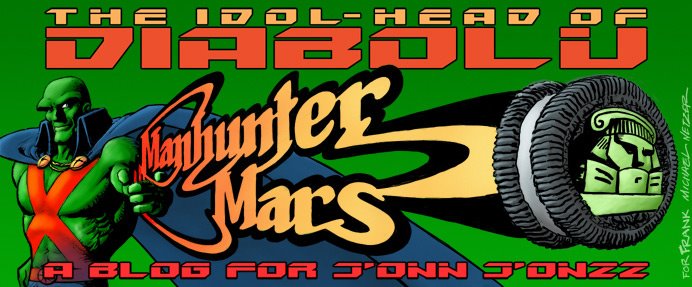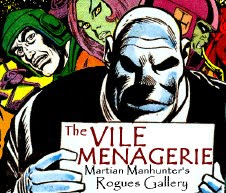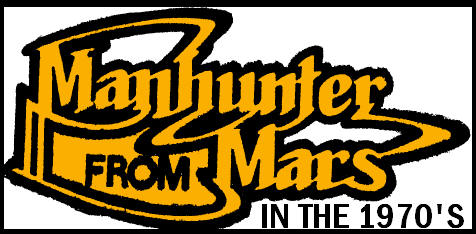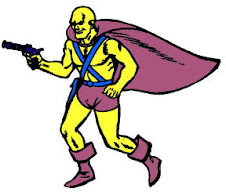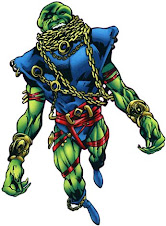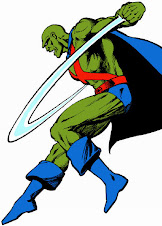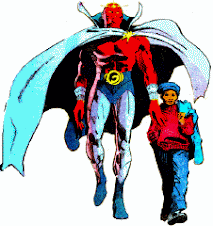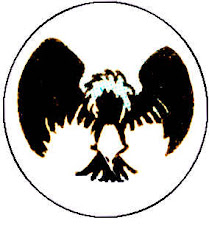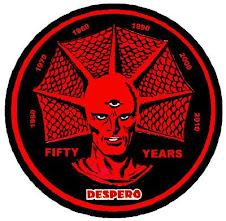Following his clash with
the Cosmic Criminals, J'onn J'onzz resumed his
search for the Martian Ark. However, to his surprise, J'onzz's spaceship picked up a distress call from his family:
mother,
father, and
brother, all once presumed lost. More puzzling, the signal came from
Phobos, a moon of Mars the Manhunter had previously scanned for signs of life. However his family had come to be there, J'onn was set on reuniting with them.
Upon setting down on Phobos, J'onzz was greeted not by his loved ones, but the humanoid sentries of Duke Dorna. The Manhunter's Justice League of America compatriot
Wonder Woman had once rescued her love Steve Trevor and Duke Dorna from a coup perpetrated by
Ghurkos. Though Duke Dorna wasn't as clearly corrupt, the Plutonian legal system presumed guilt against any accused, and J'onn J'onzz was declared suspect in the immolation of Mars by
The Blue Flame. Further, his fate would be determined through trial by combat, as was the Plutonian way, on penalty of death.
The accused was briefly jailed, sharing a cell with his old foe,
B'rett, thanks to a safety feature in his
Guard Belt that flew him to the moon when Mars perished in flames. Their reunion prompted a history lesson, recalling ancient myths of the Roman Gods having moved out into the solar system to claim worlds as their own, as was the case with Mars. Not content to reign over a planet that bore his name, Mars also sought to destroy any terrestrial gods, such as those worshiped by the green-skinned Desert Dwellers. The Albino Polar People embraced the gospel of Mars, which is why they assumed more humanoid appearances than the greens. Mars set the Martian tribes against one another, for sport and to assert dominance, aided by the lesser deities that served him.
Lord Conquest oversaw a particularly ruthless band of Polars, who forced assimilation upon captive Desert Dwellers, from which B'rett's yellow-skinned race arose. Treated as lesser beings by the white-skinned Martians, the yellows came under the sway of Lord Conquest's rival, the Duke of Deception. The Duke so loved his people that he crafted a moon of their own to live upon, and led them to
Deimos. Later, following a clash with Mars, Lord Conquest took his most fanatical followers to their own moon, Phobos, from whom the even more humanoid and Roman-influenced people of Duke Dorna were descended. Neither Green Martian nor Yellow Deimosian were welcome among the Phobosians, but only B'rett had the patronage of his personal deity in this foreign land. Not only had he declared that B'rett would survive his trial, but that he would also be free to leave for Earth aboard the soon-to-be deceased J'onzz's space ship. It was Duke Deception who had caused J'onzz to lose the trail of the Martian ark, and cast the illusion of J'onzz's family being stranded on Phobos.

All this caused the Sleuth from Outer Space to beg the question, what does God need with a starship? The Alien Atlas and the Xanthic Bandit competed in a series of Olympic-style challenges, as was the Phobosian way, each claiming an equal number of wins. Finally, the pair had to traverse perilous ground, and one wrong step meant a miles deep drop from atop a lunar plane where they had no special powers to save them. Through treachery, B'rett sent J'onzz falling to his apparent doom, while he succeeded with the aid of his still-active guard belt, giddily anticipating his rocket-powered exit from this satellite. However, Phobos could not sustain life without resources from lost Mars, so Duke Dorna and his favored would be taking the vessel for themselves, and allowing Brett to "live" for however long Phobos would keep him. Not only was B'rett enraged, but so was Duke Deception, himself trapped on Phobos by yet another rival, the Earl of Greed. Deception and B'rett joined forces against Dorna, but then the entire moon careened out of orbit.

The Martian Marvel had a history lesson of his own. Not only hadn't any of these false Roman deities of Earth "given" their followers moons, but there were never any Martian moons to begin with. 50,000 years earlier, the genius scientific survivalist
Thas Bakkus had created the two miles-wide satellites during an earlier catastrophe on Mars when the rivers dried up and oxygen disappeared. While Thas Bakkus lay in suspended animation, Martian society evolved to adapt to the atmospheric changes, and in 1955 the Manhunter from Mars was teleported to Earth. Professor Erdel's experiments had also caused Thas Bakkus to awaken from his long slumber, and after studying Earth with his cosmic rays, attempted to conquer it as a replacement for his home world. Just after John Jones had captured
“The Man of 1,000 Disguises”, Thas Bakkus caused all the humans on Earth to become his type of unevolved Martian, and obey his will. J'onzz was unaffected, but Thas Bakkus' having arrived near Earth aboard the Deimos satellite was causing gravitational calamity to the planet. While the Alien Atlas investigated Deimos and set it on a return course for Martian orbit, the human Jim Croft had thwarted Thas Bakkus himself. The Sleuth had recognized Thas Bakkus' handiwork on Phobos, and had programmed the satellite to carry its citizens to orbit a world that could sustain them. In the confusion, the Manhunter from Mars reclaimed his space ship, and made off, leaving B'rett and Duke Deception to drift through space, with only the guard belt between them...

